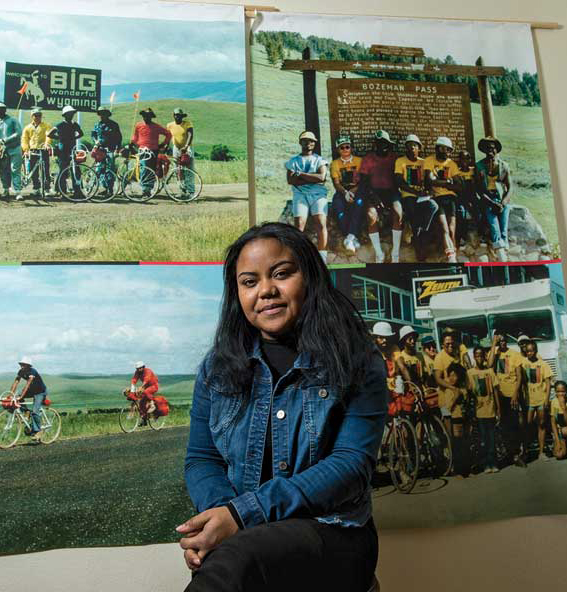- Editorial Offices
- 103 Brantly Hall
- Missoula, MT 59812
- (406) 243-2522
- themontanan@umontana.edu
Finding True Identity
UM's African-American Studies program turns 50
Meshayla Cox sits inside the Watani House, which serves as headquarters for UM’s Black Student Union. Behind her is a display of photos from 1974, when the BSU completed a re-creation of the 1897 Great Bicycle Ride of the 25th Infantry Bicycle Corps, which went from Fort Missoula to St. Louis. The infantry tested a theory that bicycles would replace horses in transporting men for the Army.
According to Tobin Miller Shearer, University of Montana history professor and director of African-American Studies, Montana is the least-black state in the Union.
“We aren’t the most white,” he says. “That’s Vermont.”
But there is a rich and vibrant African-American history in Montana, and a vital segment of that is UM’s Black Student Union and African-American Studies program.
 In fact, UM’s program – which celebrates its 50th anniversary in 2018 – is the third-oldest in the nation, following only universities in Los Angeles and Long Beach, California.
In fact, UM’s program – which celebrates its 50th anniversary in 2018 – is the third-oldest in the nation, following only universities in Los Angeles and Long Beach, California.
“That was surprising to me, because this is Montana,” says UM student Meshayla Cox, president of the Black Student Union and a double major in African-American studies and Spanish. “Stereotypically you wouldn’t think something like that existed here.
“I come from Southern California, and I grew up around all kinds of races and cultures. But when I came to school at Montana, this is where I found my identity. This is where I found my connection to who I am. And that’s amazing.”
In the fall of 1967, Esther Thamani Akbar, Dee Daniels, Herb White and Maceo “Mace” Gray founded the Black Student Union. They pressed UM President Robert Pantzer to start a Black Studies Program, and in May 1968, Chicago community activist Ulysses Doss was hired to take charge. On his first day, he hung a sign on his office door, proclaiming him “Director of Black Studies.”
“Back in the late ’60s, it was the height of the Black Power movement, the height of racial tensions in our country. The Vietnam War is going on. All of these things are swirling around,” says Murray Pierce, who graduated from UM in 1979 and currently serves as a mentor to the BSU. “And in this little bucolic city, people of color had the initiative to say, ‘No matter where I am, I’m going to be who I am.’”
Doss is renowned as an incredible educator, and students would pack lecture halls to hear him speak.
Shearer believes two keys to Doss’ tenure made the program thrive at UM. First, he offered classes to anyone in the community who showed up, noting that people would come in droves because there were so few resources at that time to become educated in these areas.
The second key, he adds, was the communal support from host families, who would welcome black students into their homes to break bread, build relationships and learn from one another. Two longtime supporters, Larry and Dianna Riley, were crucial in this aspect.
“People were forced to address issues of race in ways they hadn’t before,” Shearer says, “The program arose at a time that gave people skills and language to talk about the issues they were confronting around their kitchen tables and at family gatherings.”
African-American Studies and the BSU have evolved over the years, and the education and awareness they bring are as relevant as ever, especially to students at UM.
“I think it’s almost more important for people in places like Montana – where it’s predominantly white – to be exposed to different cultures, specifically African-American culture, because it is integral to our history,” Cox says. “It’s important to have a well-rounded perspective on the black experience and how that relates to them.”
UM now offers a major in African-American Studies, along with a minor. In honor of the 50th anniversary, Cox is spearheading the Black Solidarity Summit, which is set for mid-February. People from across the country will gather in Missoula to reflect on the past and plan for the next 50 years of African-American Studies at UM.
“We help students develop skills to express themselves and to do that in an area that is oftentimes more defined by heat rather than light,” Shearer says. “Our students bring light to the topic. And they’re equipped to do so very well.”




